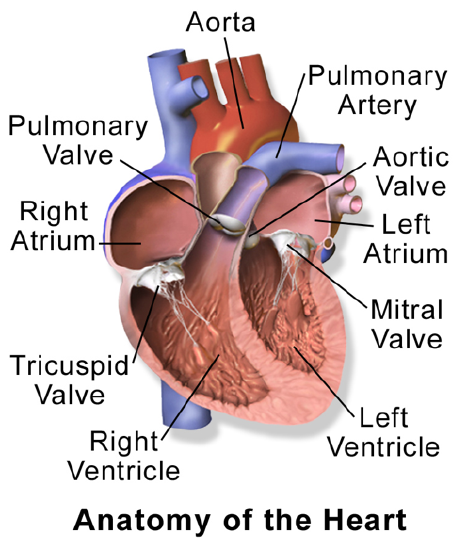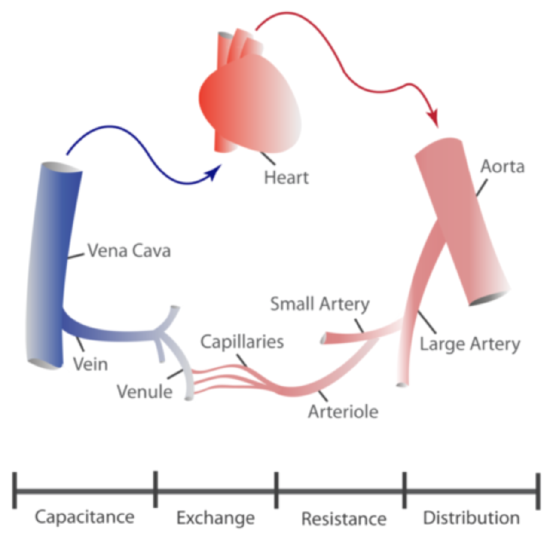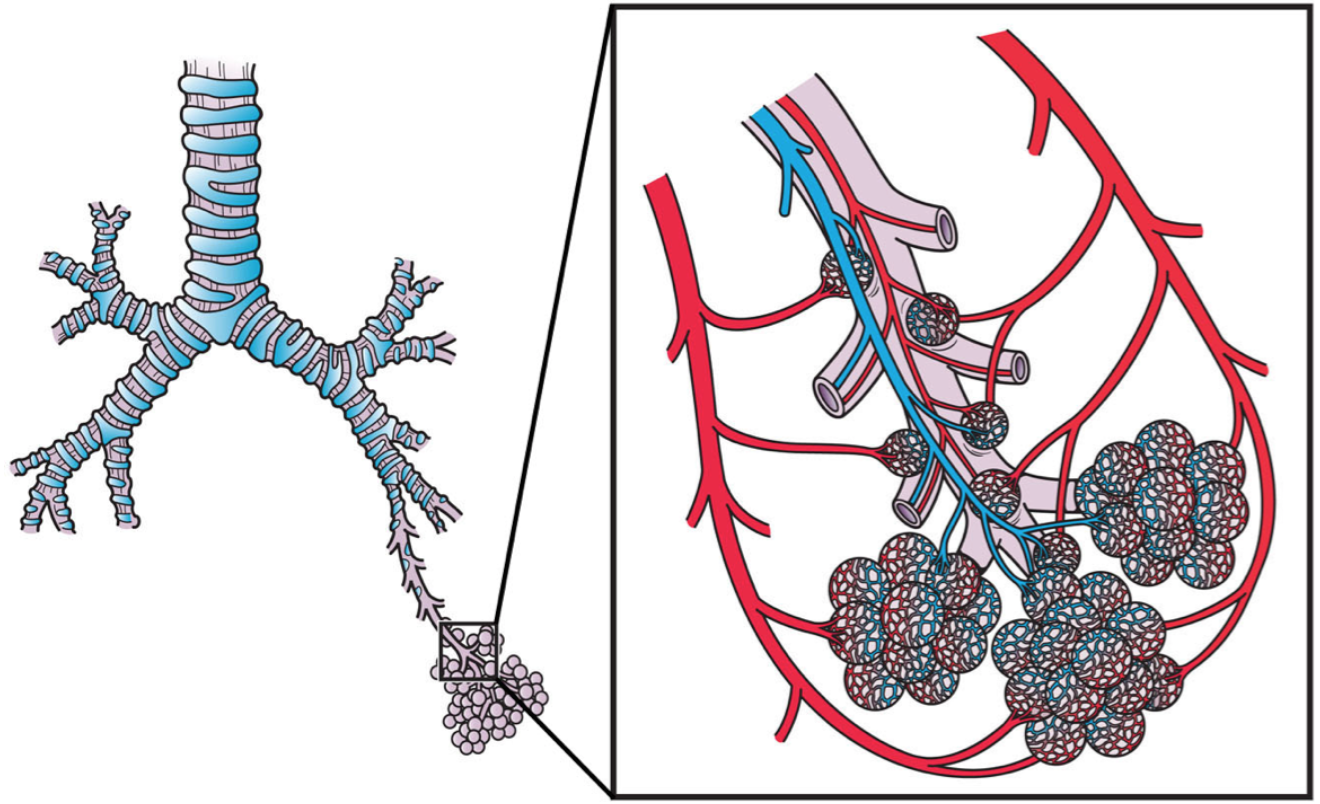Cardiovascular System Review of Principal Arteries Worksheet Answers
17.2: Introduction to the Cardiovascular System
- Page ID
- 16824
What do you lot call back Figure \(\PageIndex{1}\) shows? Does it show a maze of underground passageways in an anthill? A network of interconnected pipes in a complex plumbing organization? The picture actually shows something that, similar pismire tunnels and plumbing pipes, functions equally a transportation system. It shows a network of blood vessels. Blood vessels are role of the cardiovascular arrangement.

What is the Cardiovascular System?
The cardiovascular system, too called the circulatory system, is the organ organisation that transports materials to and from all the cells of the body. The materials carried by the cardiovascular system include oxygen from the lungs, nutrients from the digestive system, hormones from glands of the endocrine organisation, and waste product materials from cells throughout the torso. Ship of these and many other materials is necessary to maintain homeostasis of the body. The main components of the cardiovascular system are the heart, blood vessels, and claret. Each of these components is shown in Figure \(\PageIndex{ii}\) and introduced in the text.

Centre
The center is a muscular organ in the chest. Information technology consists mainly of cardiac musculus tissue and pumps blood through claret vessels by repeated, rhythmic contractions. As shown in Figure \(\PageIndex{3}\), the center has 4 inner chambers: a right atrium and ventricle and a left atrium and ventricle. On each side of the center, blood is pumped from the atrium to the ventricle below information technology and from the ventricle out of the middle. The eye also contains several valves that allow claret to flow merely in the proper management through the heart.

Unlike skeletal muscle, cardiac muscle routinely contracts without stimulation by the nervous organisation. Specialized cardiac muscle cells send out electrical impulses that stimulate the contractions. Equally a event, the atria and ventricles normally contract with just the right timing to keep blood pumping efficiently through the heart.
Blood Vessels

The blood vessels of the cardiovascular system are like a network of interconnected, one-style roads that range from superhighways to back alleys. Similar a network of roads, the claret vessels accept the chore of allowing the transport of materials from one place to another. In that location are iii major types of blood vessels: arteries, veins, and capillaries. They are illustrated in Effigy \(\PageIndex{4}\).
- Arteries are blood vessels that carry blood away from the middle (except for the arteries that really supply blood to the heart muscle). Well-nigh arteries behave oxygen-rich claret, and one of their master functions is distributing oxygen to tissues throughout the body. The smallest arteries are called arterioles.
- Veins are blood vessels that carry blood toward the middle. Most veins comport deoxygenated claret. The smallest veins are called venules.
- Capillaries are the smallest blood vessels. They connect arterioles and venules. Equally they pass through tissues, they exchange substances including oxygen with cells.
2 Circulations
Cells throughout the body need a constant supply of oxygen. They get oxygen from capillaries in the systemic apportionment. The systemic circulation is just one of two interconnected circulations that make upwards the human cardiovascular system. The other circulation is the pulmonary system. This is where the blood picks upward oxygen to carry to cells. Information technology takes blood near 20 seconds to make one complete transit through both circulations.
Pulmonary Circulation
The pulmonary circulation involves merely the heart and lungs and the major blood vessels that connect them. It is illustrated in Figure \(\PageIndex{5}\). Blood moves through the pulmonary circulation from the heart to the lungs, and back to the heart again, condign oxygenated in the procedure. Specifically, the right ventricle of the centre pumps deoxygenated blood into the right and left pulmonary arteries. These arteries bear the blood to the right and left lungs, respectively. Oxygenated blood then returns from the correct and left lungs through the ii correct and two left pulmonary veins. All four pulmonary veins enter the left atrium of the heart.

What happens to the blood while it is in the lungs? It passes through increasingly smaller arteries and finally through capillary networks surrounding the alveoli (Figure \(\PageIndex{6}\)). This is where gas exchange takes identify. The deoxygenated blood in the capillaries picks up oxygen from the alveoli and gives up carbon dioxide to the alveoli. As a consequence, the blood returning to the eye in the pulmonary veins is almost completely saturated with oxygen.

Systemic Circulation
The oxygenated blood that enters the left atrium of the center in the pulmonary circulation then passes into the systemic circulation. This is the part of the cardiovascular system that transports claret to and from all of the tissues of the torso to provide oxygen and nutrients and pick up wastes. Information technology consists of the heart and claret vessels that supply the metabolic needs of all the cells in the body, including those of the eye and lungs.

Every bit shown in Figure \(\PageIndex{7}\), in the systemic circulation, the left atrium pumps oxygenated claret to the left ventricle, which pumps the blood straight into the aorta, the body's largest avenue. Major arteries branching off the aorta carry the claret to the caput and upper extremities. The aorta continues down through the abdomen and carries blood to the abdomen and lower extremities. The blood then returns to the heart through the network of increasingly larger veins of the systemic circulation. All of the returning blood eventually collects in the superior vena cava (upper body) and junior vena cava (lower trunk), which empty directly into the right atrium of the centre.
Claret
Blood is a fluid connective tissue that circulates throughout the body in blood vessels by the pumping action of the center. Claret carries oxygen and nutrients to all the body'south cells, and information technology carries carbon dioxide and other wastes away from the cells to be excreted. Blood besides transports many other substances, defends the body confronting infection, repairs trunk tissues, and controls the body's pH, amidst other functions.
The fluid function of blood is chosen plasma. Information technology is a yellow, watery liquid that contains many dissolved substances and blood cells. Types of blood cells in plasma include red claret cells, white blood cells, and platelets, all of which are illustrated in Figure \(\PageIndex{viii}\) and explained in the text.

- Red claret cells have the chief role of carrying oxygen in the blood. Red blood cells consist more often than not of hemoglobin, a poly peptide containing fe that binds with oxygen.
- White claret cells are far fewer in number than crimson blood cells. They defend the body in various ways. For instance, white blood cells called phagocytes consume and destroy pathogens, expressionless cells, and other debris in the blood.
- Platelets are cell fragments involved in blood clotting. They stick to tears in blood vessels and to each other, forming a plug at the site of injury. They also release chemicals that are needed for clotting to occur.
Review
- What is the cardiovascular system? What are its main components?
- Depict the heart and how it functions.
- List the three major types of blood vessels and their basic functions.
- Compare and contrast the pulmonary and systemic circulations.
- What is blood? What are its principal constituents?
- True or False. The circulatory system brings blood to and from the body, while the cardiovascular system brings blood to and from the lungs merely.
- True or False. Arteries behave mainly oxygenated blood.
- Name 3 unlike types of substances that are transported by the cardiovascular system.
- Describe where and how the pulmonary and systemic circulation systems run into.
- Which of the following carries blood to the lungs? Cull all that apply.
A. Left pulmonary artery
B. Left pulmonary vein
C. Right pulmonary artery
D. Right pulmonary vein
- Put the post-obit structures in order of how blood flows from the eye out to the body and back over again.
capillaries; venules; aorta; veins; arteries
- Explain why the heart and lungs need blood from the systemic circulation.
- Choose ane. Blood vessels carrying deoxygenated blood from the body back to the heart get increasingly (larger/smaller).
- Blood becomes oxygenated in the lungs through gas commutation into:
A. Arterioles
B. Capillaries
C. Venules
D. Bronchioles
- Which type of claret cell carries oxygen?
Explore More than
Source: https://bio.libretexts.org/Bookshelves/Human_Biology/Book:_Human_Biology_%28Wakim_and_Grewal%29/17:_Cardiovascular_System/17.2:_Introduction_to_the_Cardiovascular_System
0 Response to "Cardiovascular System Review of Principal Arteries Worksheet Answers"
Post a Comment